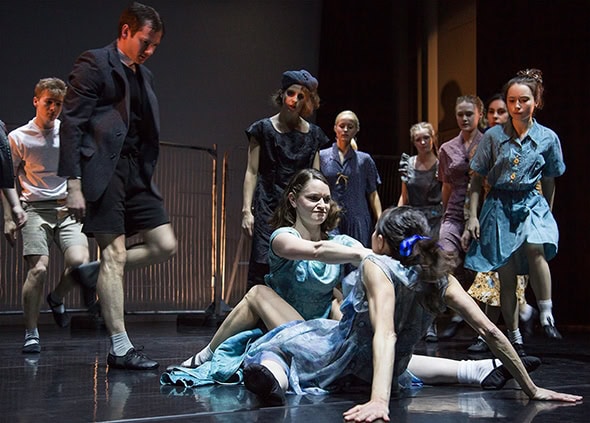Yorke Dance Project in Twenty at Clore Studio
Posted: May 27th, 2019 | Author: Nicholas Minns & Caterina Albano | Filed under: Performance | Tags: Abigail Attard Montalto, Charlotte MacMillan, Clore Studio, Dane Hurst, Freya Jeffs, Gordon Crosse, John B. Read, Jordi Calpe Serrats, Oxana Panchenko, Playground, Robert Cohan, Sir Kenneth MacMillan, Sophia Stoller, Stephen Wicks, Susie Crow, Twenty, Yolanda Sonnabend, Yolanda Yorke-Edgell, Yorke Dance Project | Comments Off on Yorke Dance Project in Twenty at Clore StudioYorke Dance Project, Twenty, Clore Studio at the Royal Opera House, May 16

Yorke Dance Project is celebrating its twentieth anniversary with a choreographic landscape that ranges from a revival of a work by Sir Kenneth MacMillan to new works by Robert Cohan, Sophia Stoller and company founder, Yolande Yorke-Edgell. This landscape contains within it other landscapes, for Cohan, as an early Martha Graham dancer, sees his ever-present mentor in the distance and quotes from an earlier work of his own, while Yorke-Edgell revisits some of the choreographers who have influenced and inspired her, notably Richard Alston, Bella Lewitsky and Cohan himself.
MacMillan’s Playground from 1979 is very much in the foreground for its visual imagery, its rhythmic cohesion with the music of Gordon Crosse and the spatial richness of its groupings. From Gordon Anthony’s photographs in the program of the original set, Yolanda Sonnabend had created a sense of oppression through the suggestion of a wire mesh cage; for Yorke Dance in the Clore Studio, Charlotte MacMillan has reimagined a more portable industrial fencing that might surround a building site. Seeing Playground is to be reminded how uncompromising MacMillan was in portraying the seamy side of social and ethical questions that classical ballet rarely if ever treats. And although he uses the visual stimulus of costumes and set, he tells his story principally through a masterful handling of classical technique in the tortured image of a twentieth-century zeitgeist. The playground of the title comes from Crosse’s score, Play Ground, but it also refers to an enclosed, isolated world in which adults dressed as school children play out their noxious games of rivalry and jealousy under the watchful eye of two clinicians in white. The issues of madness, sanity and debilitating neurological disease — the principal girl, like MacMillan’s mother, has epilepsy — are close to the surface and unresolved, giving the work its unsettling character. There are two principal characters — The Girl with Makeup and The Youth — and a large supporting cast for which Yorke Dance invited a number of guests. Oxana Panchenko alternates with Romany Pajdak as the Girl while Jordi Calpe Serrats alternates with Jonathan Goddard as the Youth. The production is given added credibility by the assistance of Susie Crow and Stephen Wicks from the original cast and Jane Elliott as notator; the power of the choreography comes through even if the images of distress at its centre are not always fully realized.
Coming at the beginning of the program, Playground overshadows the remaining works for different reasons. Stoller’s Between and Within is created on two couples (Edd Mitton, Freya Jeffs, Dane Hurst and Abigail Attard Montalto) whose all too familiar choreographic vocabulary fails to explore with any clarity the relationship between them while Justin Scheid’s composition accompanies the dancers without becoming involved in the choreography. It’s a well-crafted work but lacks the visual and emotional signals that give dance meaning.
At the age of 94, it is perhaps not surprising that Robert Cohan’s new work, Communion, looks into the past for inspiration, but it’s a little too far for the current cast to fully comprehend. Communion’s aesthetic is a minimalist ritual celebration that Cohan’s old friend and lighting designer John B. Reid has lit superbly. Both the choreography and the lighting seem to take their inspiration from the heavenward aspirations of a gothic cathedral and could indeed be performed in one; there is a pull in the choreography between heaven and earth — as in Martha Graham’s work — in which the dancers are held back from ascending only by the force of their gravity. In the secular scale of the Clore Studio, however, the muscular presence of the dancers in shorts and sleeveless tops leads aspiration into a rather lackadaisical disenchantment, especially in the formal patterns of walking. The music was intended to be shared between MuOM, Barcelona Overtone Singing Choir and Nils Frahm, which might have provided a more spiritual aural space than the unexplained substitute of MuOM by an additional selection of Frahm’s rather saccharine piano mixes.
Yorke-Edgell’s Imprint is a new work for her company’s anniversary celebration, created ‘from the imprint of a purely physical memory’ of the work of different choreographers over the course of her dance career. She uses the form of pastiche in choreography, music and recorded text to honour her mentors but channelling five composers and three choreographers through the bodies of fifteen dancers can only be sustained in a spirit of celebration. The imprint of her solo for Freya Jeffs, however, carries an element of truth that endures.